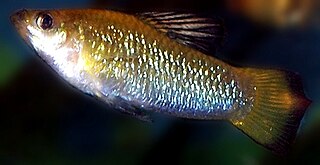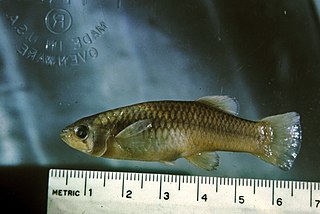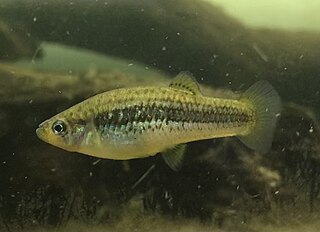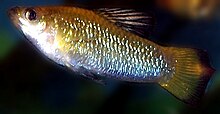
Poecilia is a genus of fishes in the family Poeciliidae of the order Cyprinodontiformes. These livebearers are native to fresh, brackish and salt water in the Americas, and some species in the genus are euryhaline. A few have adapted to living in waters that contain high levels of toxic hydrogen sulfide and a population of P. mexicana lives in caves.

Limia is a genus of livebearing fishes belonging to the Cyprinodontiform family Poeciliidae, which includes other livebearers such as platys, swordtails, guppies and mollies. They are found in fresh and brackish water. Of the 21 described Limia species, 17 are endemic to Hispaniola, one is found on both Hispaniola and Jamaica, and the Cayman Islands, Cuba, and Venezuela have an endemic species each. Limia are popular in aquaria among more advanced hobbyists.
The San Marcos gambusia is an extinct species of gambusia from the family Poeciliidae that was found only in the San Marcos Springs of Central Texas. The fish has not been seen since 1983. The specific name of this fish honors the American ichthyologist George S. Myers (1905-1985).
The Lake Rukwa lampeye is a species of fish in the family Poeciliidae. Its natural habitats are intermittent rivers, freshwater marshes, and intermittent freshwater marshes. It is threatened by habitat loss. This species occurs in central Africa in Lake Rukwa, Tanzania, the Malagarasi River, Wembere River system and the upper basin of the Congo River. Its specific name honours the German physician and zoologist Friedrich Fülleborn (1866-1933), who collected the type.
The mesh-scaled topminnow is a species of fish in the family Poeciliidae. The two population groups are a southern group of populations found in Angola, Botswana, the Republic of the Congo, Malawi, Mozambique, and Zambia and a northern population group found in Chad, the Central African Republic, the White Nile in South Sudan and Sudan and in the northern Democratic Republic of Congo. Its natural habitat is small streams and brooks, lakes, and swamps on floodplains where it lives among aquatic vegetation. This species was described by George Albert Boulenger as Haplochilus hutereaui in 1913 with the type locality being Dungu on the upper Uelé River in the Democratic Republic of Congo. Boulenger received the type from Armand Hutereau (1875-1914), who was the head of a Belgian ethnographic expedition to the Congo, so he honoured Hutereau in the specific name.
The yellowfin gambusia is a species of fish in the family Poeciliidae. It is endemic to the Rio Conchos of Chihuahua, Mexico, where it is known as guayacon de san gregorio. This species was described in 1957 by Clark Hubbs and Victor G. Springer with the type locality given as El Ojo de San Gregorio in Chihuahua. The specific name of this fish honours the Mexican ichthyologist José Alvarez del Villar (1903-1986) for his work on the fishes of Mexico and for his assistance to Clark and Springer.

The Big Bend gambusia is a rare species of fish in the family Poeciliidae. It is endemic to the Big Bend region of the Rio Grande of the United States and Mexico. The only known remaining population is in a protected pond in the Big Bend National Park.

Gambusia hurtadoi, also known as crescent gambusia, is a species of fish in the family Poeciliidae. It is endemic to Chihuahua in Mexico, where it is known as guayacon de Hacienda Dolores. It grows to 3.5 cm (1.4 in) total length. The species was described in 1957 by Carl Leavitt Hubbs and Victor G. Springer with the type locality given as El Ojo de la Hacienda Dolores, 7 miles south of Jiminez, Chihuahua, the spring to which this species is endemic. Hubbs and Springer honoured the Mexican Leopoldo Hurtado Olin of the Departamento de Economía in Chihuahua for his assistance during their collecting expedition to Chihuahua in June 1951. Hurtado Olin also informed Hubbs and Springer of the location of El Ojo de la Hacienda Dolores.

The ornate paradisefish or spotted gourami, is a species of gourami endemic to Sri Lanka. It is the only recognized species in its genus.

Nothobranchius korthausae is a species of killifish in the family Nothobranchiidae. It is endemic to Mafia Island in Tanzania. Its natural habitat is pools, ditches and small streams. The specific name of this species honours the German aquarist Edith Korthaus who collected the type.
The Mnanzini nothobranch is a species of killifish in the family Nothobranchiidae. It is endemic to Kenya where it occurs on the floodplains of the lower Tana River system where it is found in temporary waterbodies and connecting streams. The specific name honours the German aquarist Manfred Willert who helped to collect the type and who donated it to Rudolf Hans Wildekamp who describe the species in 1992.
The eastcoast lampeye is a species of fish in the family Poeciliidae. It is endemic to coastal Kenya and Tanzania, where found in brackish water, mangrove swamps, pools, lagoons and river deltas. It reaches up to 5 cm (2.0 in) in total length. This fish was described by Ernst Ahl as Haplochilichthys stuhlmanni with the type locality given as Tanganyika Territory. The specific name honours the co-leader of the German East Africa Expedition (1889-1892) on which type was collected, Franz Ludwig Stuhlmann (1863-1928) of the German Colonial Service.

The marbled swordtail is a species of freshwater fish in the family Poeciliidae. It was endemic to the Rio Salado system in northeastern Mexico.

The pike topminnow, also known as the top minnow, is a species of poeciliid found from Mexico to Costa Rica. It has also been introduced to Florida, USA. The female of the species grows to a total length of 20 cm (7.9 in), with males growing to 10 cm (3.9 in). It is the only known member of its genus. Unlike most poeciliids, this is a highly specialized predator, with an extremely flexible upper jaw that enables it to take very large prey items for its size. The pike topminnow was described in 1860 by Austrian ichthyologist Rudolf Kner, who gave the type locality as Belize, which is reflected in this species' specific name.
Xiphophorus nezahualcoyotl, the mountain swordtail, is a live bearing fish in the family Poeciliidae. It is endemic to the northwestern Pánuco River basin in Mexico. The specific name of this fish refers to the poet, philosopher and emperor of Texcoco, Nezahualcoyotl (1402-1472).

The emerald aphyosemion is a species of killifish, endemic to the lower Cross River basin in Nigeria. It is a coastal rainforest fish which lives in small streams and ponds. It prefers a temperature of around 75 °F (24 °C), and a slightly acidic pH around 6–7. The specific name honours the Danish count, army colonel, explorer and ichthyologist Jørgen J. Scheel (1916–1989).
Xiphophorus birchmanni, commonly known as the sheepheadswordtail, is a live bearing fish in the family Poeciliidae.
Limia melanonotata, the blackbanded limia, is a toothcarp in the family Poeciliidae. It is endemic to the island of Hispaniola.

The Nile killifish, also known as the Nile lampeye, is a species of killifish from the family Poeciliidae. It is found in the White Nile drainage in Sudan, the Nile Delta in Egypt, the Wembere and Malagarasi Rivers in Tanzania and in the Lake Victoria basin in Uganda and Tanzania. However, it is thought to have been extirpated from Egypt, the introduction of alien poecilid fish, agricultural pollution and increasing salinity are all thought to have contributed to its local extinction in the Nile Delta.
Alfaro huberi is a species of killifish, one of the livebearers in the family Poeciliidae, in the New World subfamily Poeciliinae. It is found in clear, fast flowing streams in Central America where it has been recorded from Honduras, Guatemala and Nicaragua. This fish was formally described in 1923 as Priapichthys huberi by Henry Weed Fowler with the type locality given as Marceligo Creek which is a tributary of the Río Tunky at Miranda in Nicaragua. The specific name honours the Curator of Mammals at the Academy of Natural Sciences of Philadelphia Wharton Huber (1877-1942), a colleague of Fowlers, who collected the type.











